Imagine you’re in the middle of the Pacific Ocean. Behind you is China, below you are thousands of tonnes of consumer goods destined for faraway ports, then stores, then maybe a spot beneath a Christmas tree. You are part of a vast economy that supplies the things we buy — a galaxy of cities, systems and people that is largely unacknowledged and rarely seen. Unless you know where to look.
Liam Young and Kate Davies, a pair of designers and researchers based in London, know where to look, and have done just that. As part of their ongoing design research studio called Unknown Fields Division, they have been focused on parts of the world that even fewer people have ever visited: Tracing the supply chain of the global economy in reverse, documenting the complex systems and spaces that deliver electronics and other products to stores all over the world.
Imagine their route as the reverse of the path your new smartphone might take on its way to your door. The crew began by climbing aboard massive cargo ships bound for Chinese ports, then docked along with thousands of cargo containers. Then on to the massive wholesale market where international buyers snap up everything from Christmas decorations and RC planes; then to the factories and worker dorms themselves, and then deeper into Inner Mongolia, to the villages where the rare earth elements used to build electronics are mined.
Like macro-scale detectives, they began at the end and traced the supply chain back to the very beginning, when the circuitry in your phone was just dust in an Inner Mongolian mine. In doing so, they documented the vast landscape of the global economy.
“What we’re trying to do is talk about this extraordinary, planetary-scale infrastructural system that we’ve put in place that most of the world doesn’t know exists,” Young tells me over the phone after having returned from the second of two trips to Asia. “The scale and production of infrastructure required to deliver the world that we know is utterly extraordinary, but it’s so big and so ubiquitous that it’s kind of become invisible,” he adds. “This project is trying to reveal the systems behind modern living.”

Scores of workers line the continuously moving conveyor belts of a Microwave oven factory in China. Picture: Liam Young/Unknown Fields.
4. The Cargo Ships
Since Young and Davies decided to trace the supply chain in reverse, the last leg of your average gadget’s journey was actually their first leg: The massive cargo ships themselves.
Hitching a ride on some of the world’s most advanced commercial ships was, as Young tells me, mostly just a matter of asking. They contacted Maersk, the Danish company that is by far the biggest shipping corporation in the world, to ask that it allow six of their members aboard Maersk vessels arriving in Yantian, a port in Shenzhen, around the same time. After he had assured Maersk’s reps that the group wasn’t preparing an expose on international shipping, things fell into place quickly.
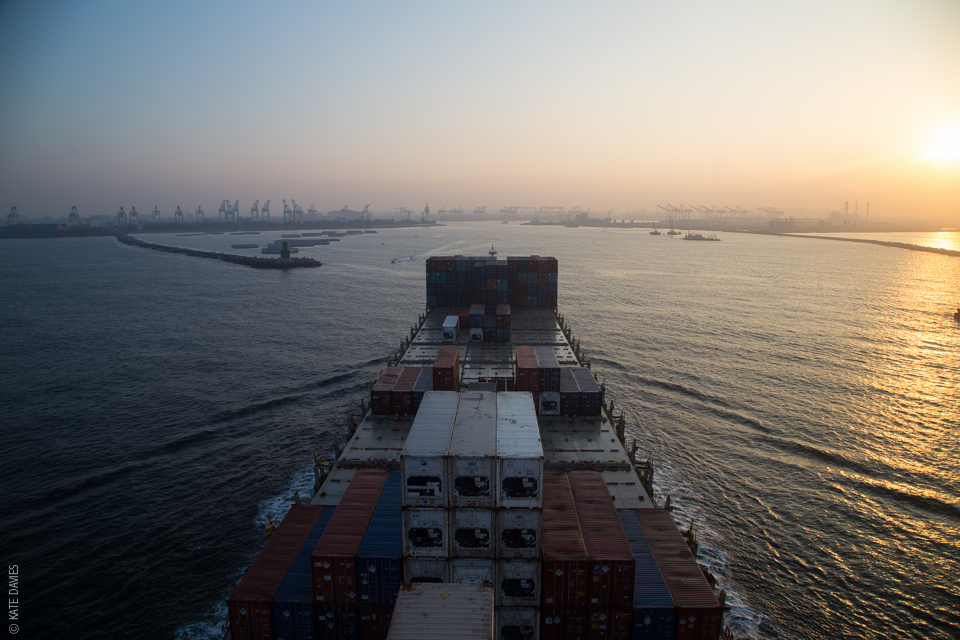
Cargo ship, CMA CGM Blue Whale, arriving in Kaohsiung port, Taiwan en route to China. Picture: Kate Davies/Unknown Fields.
Aboard six different Maersk cargo ships all destined for Shenzhen, the members of Young and Davies’ expedition got a taste of life aboard the ships that are the lifeblood of the global economy. Author Rose George famously described the importance of cargo ships by describing the fact that “90 per cent of everything” you own arrived via a cargo ship. Without these vessels, the global economy wouldn’t exist.
The Unknown Fields crew lived by the crew schedule during their time aboard the ships, eating with Maersk’s employees and shadowing them throughout the days. They traveled along some of the busiest shipping lanes in the world, finding out how life as a sailor has changed since the advent of modern shipping. In short — it’s changed completely.
A century ago, crew members enjoyed the perks of shore leave when in port, because of the sometimes weeks-long process of loading and unloading the cargo aboard the ships. But because that’s all been automated with robotic crane operators and cargo container mechanisms which allow cargo to be unloaded in hours, shore leave is a thing of the past. So the visitors were a welcome novelty to the crew, most of whom were on long, 14- to 16-month contracts.

Unknown Fields explorers stand dwarfed beside a Maersk cargo ship loading containers at Shanghai port. Picture: Liam Young/Unknown Fields.
Young describes the crew as exceptionally welcoming and eager to share the culture of the ship with the researchers. For example, the nationality of each captain ends up defining much about life on board, right down to the food served to the crew. “You have these strange drifting pockets of England, or India, or Philippines, drifting across the ocean,” Young says.
Often, the crew doesn’t know the cargo they’re carrying — unless it’s hazardous or needs refrigeration. Young’s ship, for example, was carrying fish meal from South America to China, where it’s used as feed in China’s massive agricultural and livestock industry. “Beyond that, the crew knows nothing about what’s in the containers,” he says. “They like to speculate. They like to imagine what it is they’re transiting around the world.” But most of the time, they only find out if an errant container pops open.
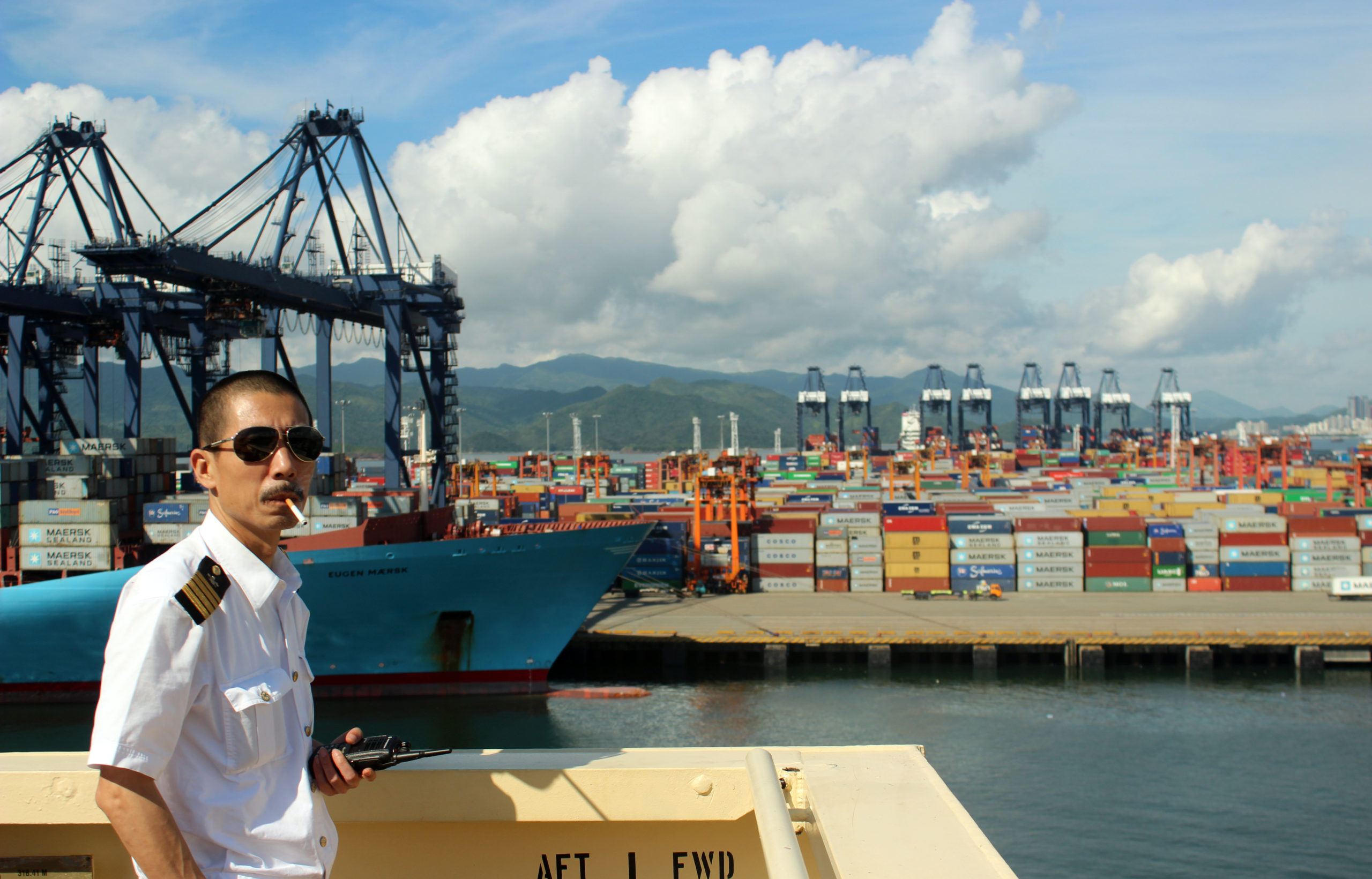
A specialist pilot climbs aboard the Maersk Seletar container ship to guide it safely into Ningbo Port. Picture: Liam Young/Unknown Fields.
Almost everything about the container ship is automated, with special algorithms that dictate the most efficient methods of loading and unloading each and every container. “What the container process has done is turned the sea, which was once this site of mythology and folklore, into a landscape of utter efficiency and economy,” Young says.
Depending on the size of the ship, there might be as many as 10,000 cargo containers on board, and the Port of Shenzhen, of which Yantian is part, and it can handle up to 6.2 million TEUs — or shipping containers — every year, according to its website. To give you an idea of the scale of the shipping economy, it’s estimated that 10,000 containers are simply lost at sea every year, either because of storms or accidents.
One thing the algorithms and robot arms can’t control: The weather. Entering into Yantian Port, a typhoon laid up all the Maersk ships in what Young describes as great oceanside parking lot off the coast of China. They sat for 48 hours, sending messages to other ships over the radio and waiting for the waves gusseting the coastline to subside. Once the ship had dropped anchor, containers were being unloaded in less than five minutes.

From the deck of the Maersk cargo ship the vast container fields of Ningbo Port, China, stretch to the horizon. Picture: Liam Young/Unknown Fields.
3. The Wholesale Marketplace
If you’ve ever walked into a 99 cent store and wondered Where the hell do all these objects come from?, the answer would almost definitely be the wholesale market at Yiwu.
This is the largest wholesale market in the world. It is the place where factories and foreign businesses meet to strike deals, within thousands of warren-like arcades where shed upon shed of goods await. Young describes it as a city-sized market, where a suburb might be dedicated to, say, fake flowers or inflatable toys or LEDs. “It’s production and consumption at the most extraordinary scale,” he says.
Inside this expansive market city, businesses from around the world come to purchase wholesale goods. They stay in the ring of the hotels that edged the city like a moat, and hook up with one of many middlemen who can help them with negotiations and navigation through the cavernous space. “They walk the city, they meet the owners, they collect samples, and they make their orders,” says Young.
What happens next is a miniature version of the global shipping process: The middlemen go to the shipping companies to reserve space — whether half a container or 50 containers — for the client’s goods. Then, they’re taken to an inland port, which Young describes as a “small pocket of international space, like an airport,” where the goods go through customs. Finally, they’re loaded onto ships and sent off into the world’s shipping lanes.
2. The Factories
Now remember, Young and Davies were tracing the supply chain in reverse, and before any of the wholesale market keepers get their goods, the products must be manufactured.
So, on each of the two expeditions, the group visited a broad range of factories and worker’s dorms to see the actual manufacturing process. They went to the factory where Whirlpool makes it microwaves, and the factory where RC helicopters are produced. They went to glitter factories, Christmas decoration factories, and GPS factories.
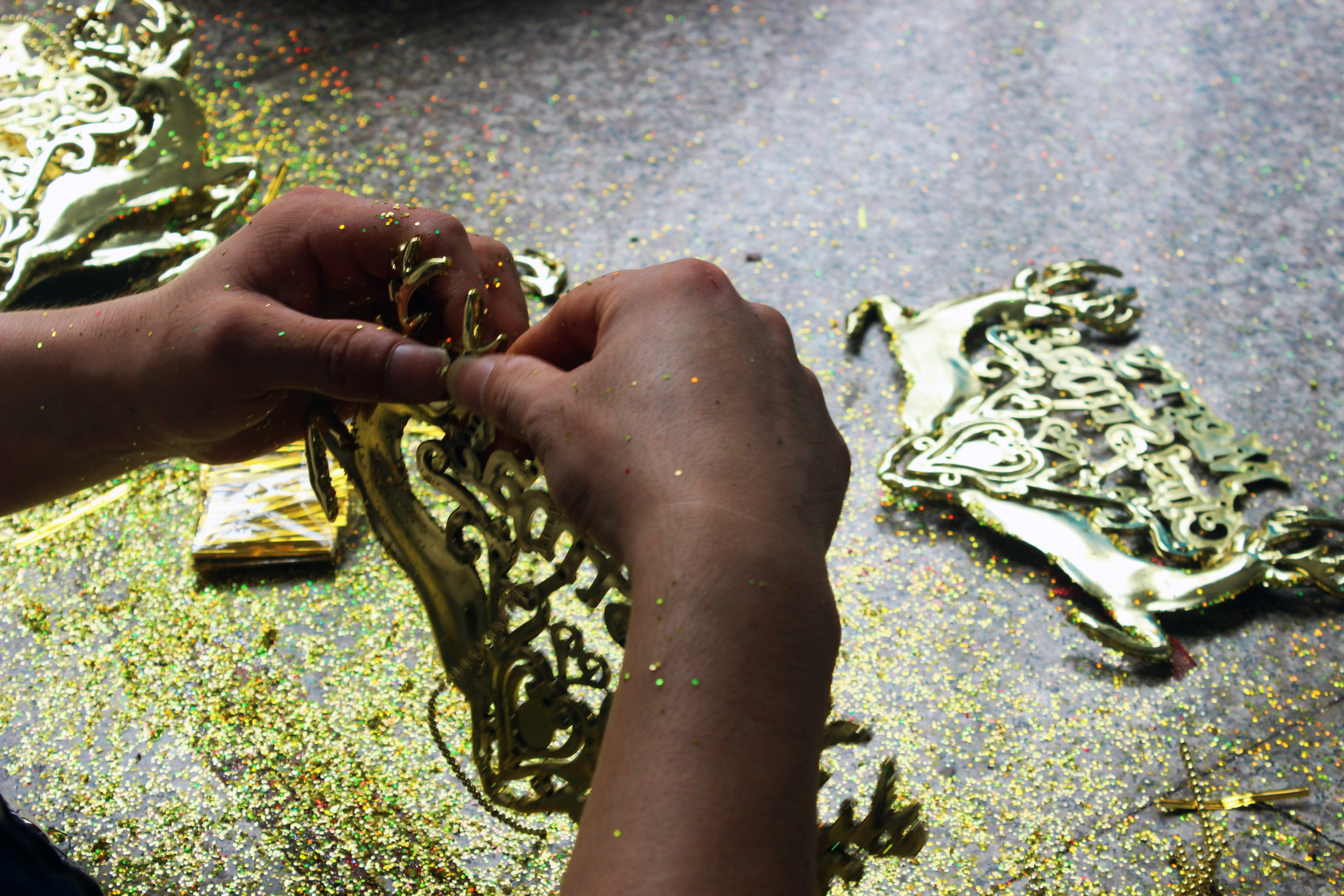


Christmas decoration Factory, Yiwu, China.
In a Christmas decorations factory in China, young girls, paid per unit, feverishly glue and stitch decorations to red felt Santa’s hats and tree ornaments before export to an American department store. Picture: Liam Young/Unknown Fields.
They also travelled through a village called Guiyu, a small town that would probably not be as well-known but for its reputation as an “e-waste village,” where the dominant industry is salvaging precious metals and materials from within the detritus of used electronics. There, poor families break down parts from stacks of old computers and electronics to scrap together the precious metals and rare earth minerals inside.
It’s a tragic place, and it was the subject of a 60 Minutes in 2008 called “Following the Trail of Toxic E-Waste,” which exposed what one analyst called “the dirty little secret of the electronic age:” That Western e-waste ends up in villages around the world, where the poor expose themselves to toxic and carcinogenic chemicals in order to scrap what valuable materials remain inside.
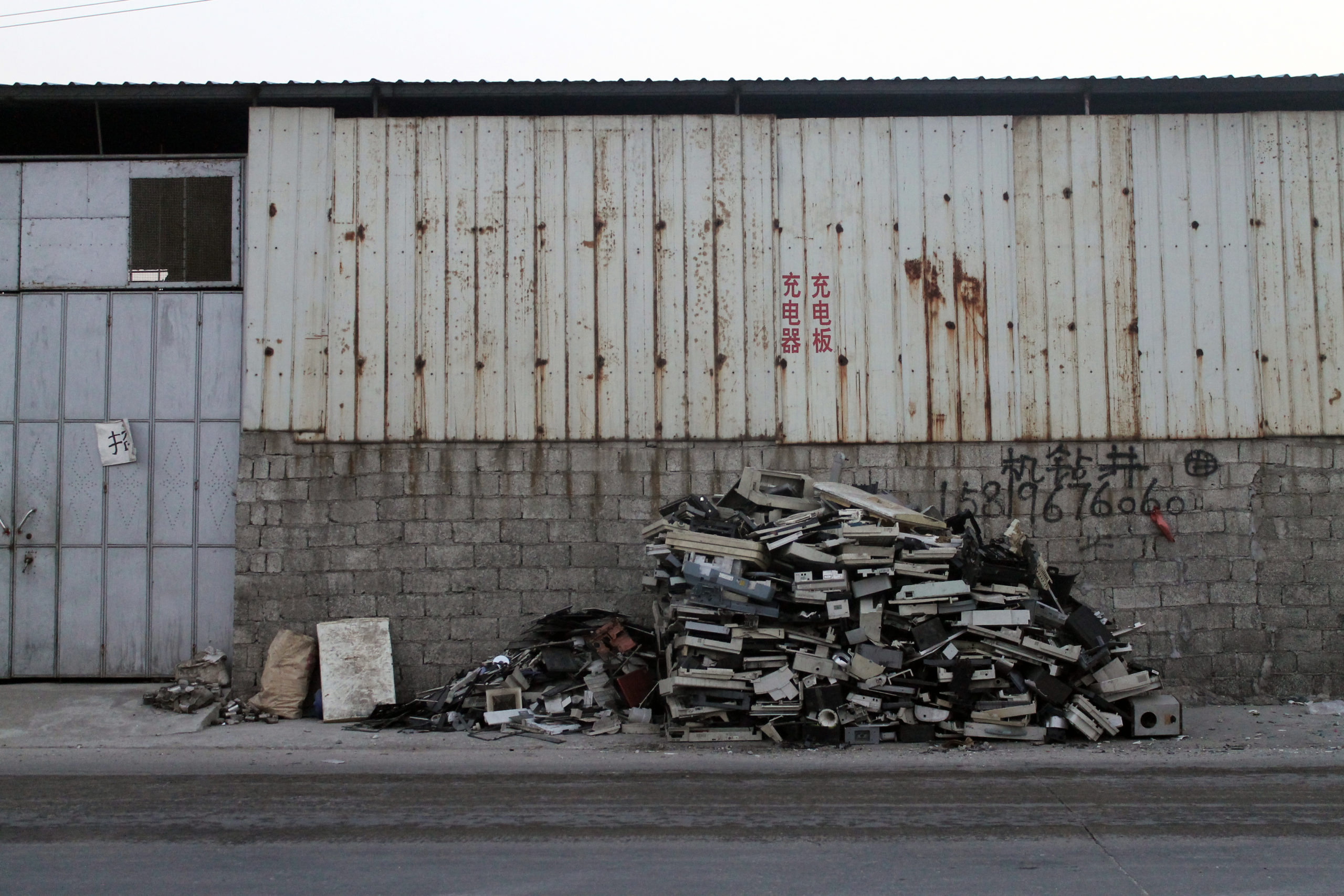
Stacks of sorted components line the streets of Giuyu e-waste recycling village waiting to be processed. Picture: Liam Young/Unknown Fields.
After the 60 Minutes story aired, it seemed the Chinese government had cracked down on Guiyu’s booming e-waste operation. But Young says that what really happened is that it went underground — or more specifically, inside. “Actually what happened is that the industry has moved from the street and into peoples’ houses,” he says. “So now this new form of mining is now a domestic industry, where a circuit board bubbles away to refine the copper next to a pot of noodles in someone’s kitchen.”
“It’s too easy for people to sit in an air conditioned flat in New York or London, tweeting on laptops and talking on their phones about the horrors of the rare earth mining industry or cheap production and exploitative labour in China,” Young says. The reality is much worse.
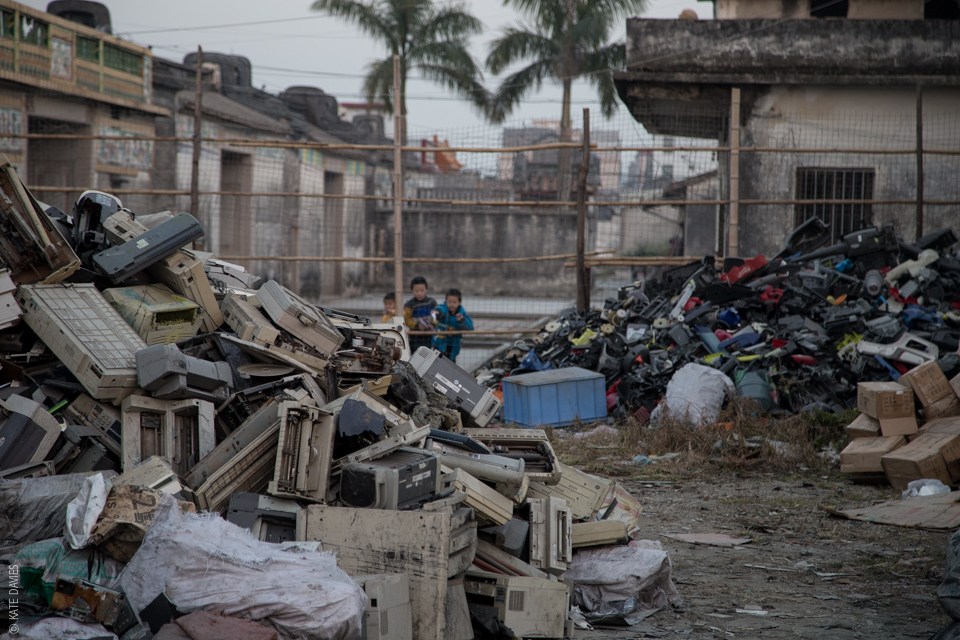
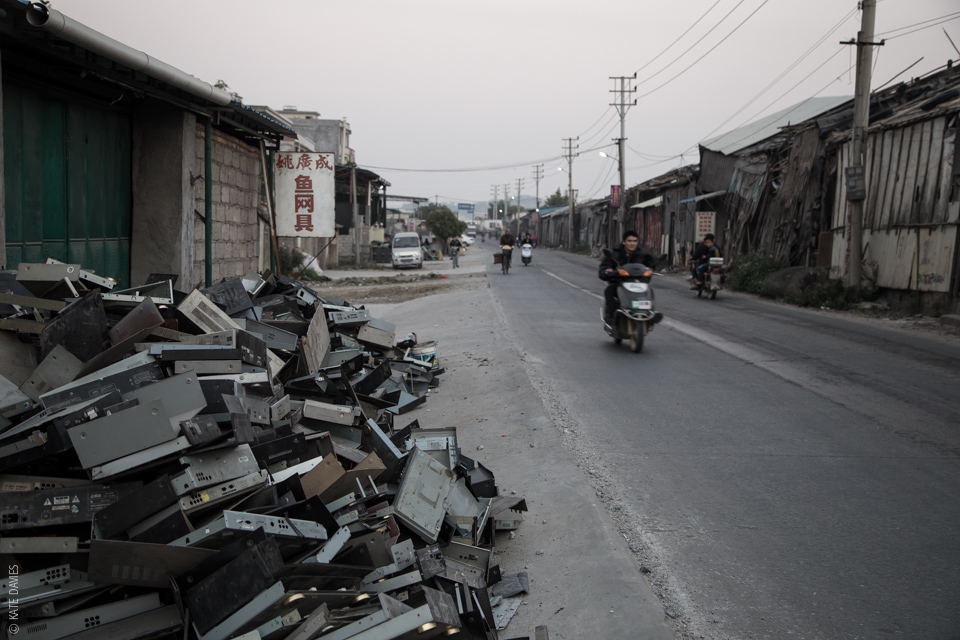
Local Children playing amongst stacks of plastic casings stripped of their electronics: Guiyu e-waste recycling village southern China. Picture: Kate Davies/Unknown Fields.
1. The Rare Earth Mines
There was one last stop on their tour: The remote rare earth metal refineries from which all of those electronics and products partially emerge.
So the group travelled deeper into mainland China, eventually reaching Inner Mongolia, where as much as 95 per cent of the world’s rare earth metals emerge from mines. These are the minerals and metals that power the modern world: The dust that emerged from these mines eventually makes its way into our smartphones, our electric cars, our laptops, our TVs, our power tools, nearly anything electronic.
There are many different types of rare earth elements, ranging from Lanthanum — used in camera lenses and batteries — to Gadolinium, used in everything from lasers to magnets. And China controls the lion’s share of them, which has allowed it to exert political pressure on the outside world by reducing the amount of metals available to export.
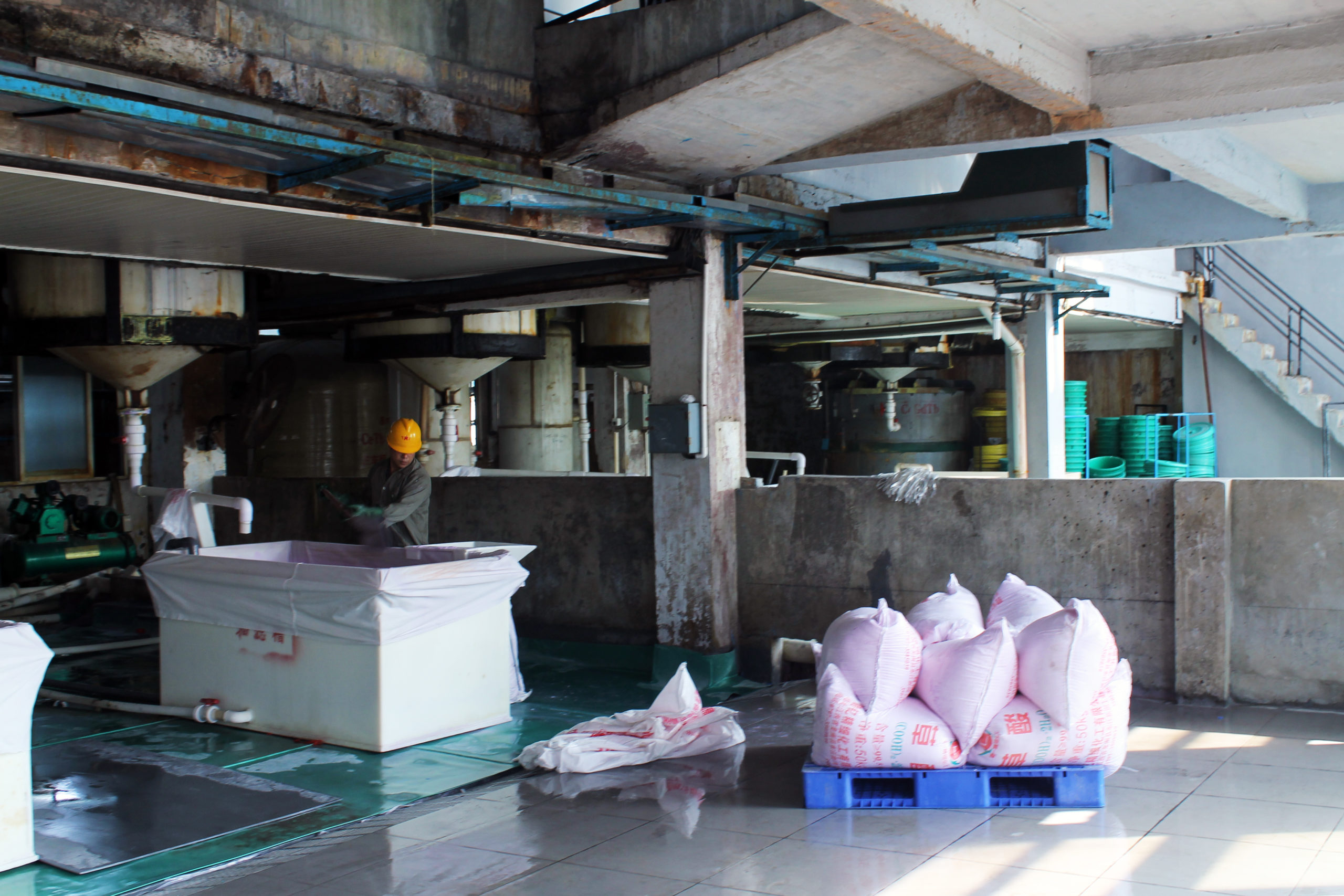
Inside a rare earth processing plant bags of refined minerals are stacked before being transported to electronics manufacturers. Image © Liam Young/Unknown Fields.
To gain access to these places, Unknown Fields had to go through the lobbying group that controls prices and labour regulations in the mines. The lobby acted as liaison between the group and the factory owners. The first thing that the owners did? Take the group out for a traditional — and very boozy — lunch, part of the business culture of the region.
“There is one day that’s been wiped from my memory,” laughs Young. “The owner of a rare earth processing plant that produces the mineral that’s used to polish smartphone screens took us for a traditional Mongolian lunch, which includes a traditional drinking ceremony with extraordinarily potent alcohol.”
Despite the hospitality, the mine bosses were careful about allowing the group access to certain areas of the operations, whether for secrecy or the toxicity of the spaces. So Young and Davies spent most of their week navigating back roads and countryside with the help of only GPS coordinates and satellite print-outs. “It was a long couple of days,” says Young, who recalls trekking for half a day to find a good vantage point to photograph some of the sites. One area they didn’t need GPS to find was the massive toxic lake — or tailings pond — where the byproducts of the mining process end up. “We just drove right up to it,” he says.
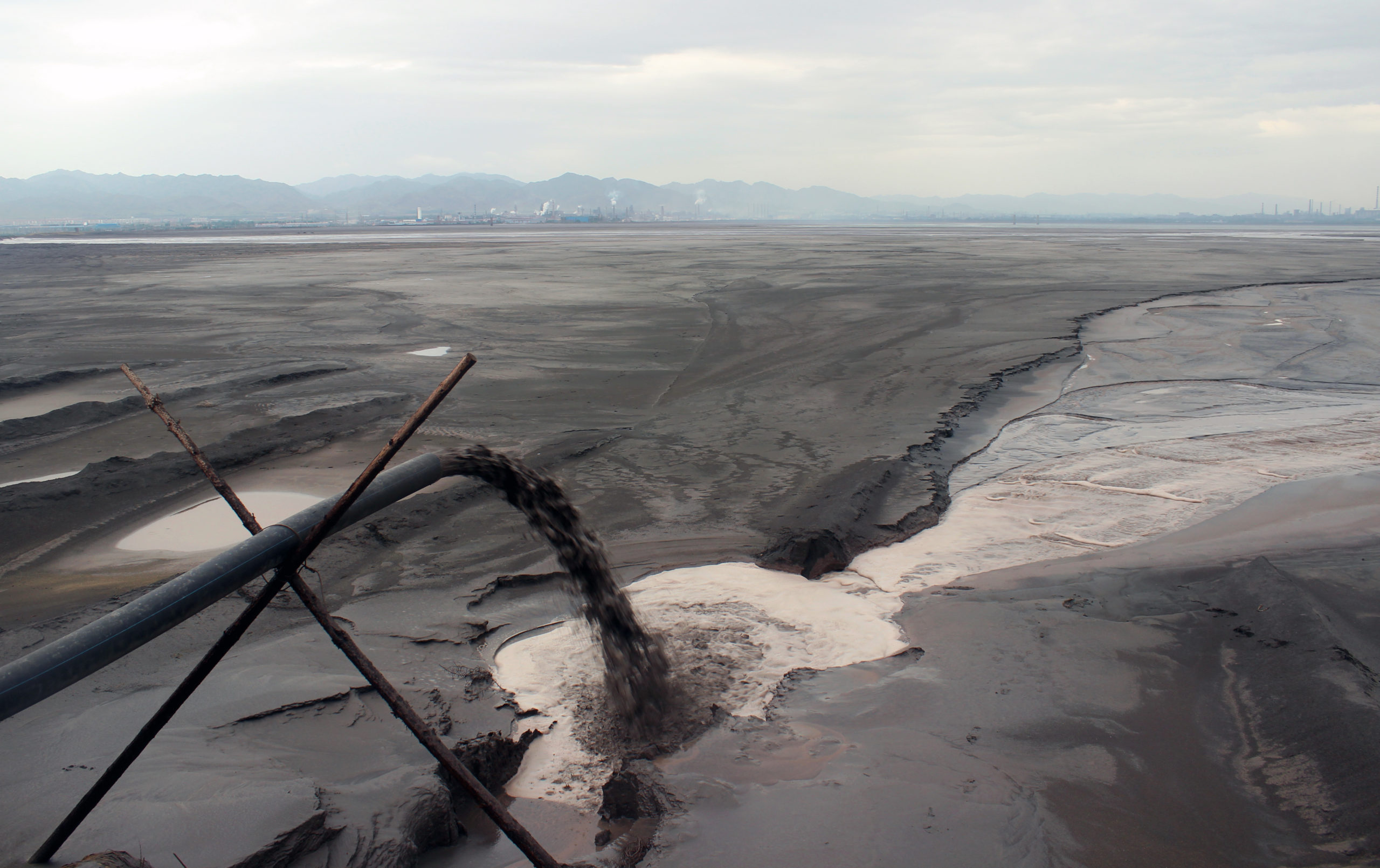
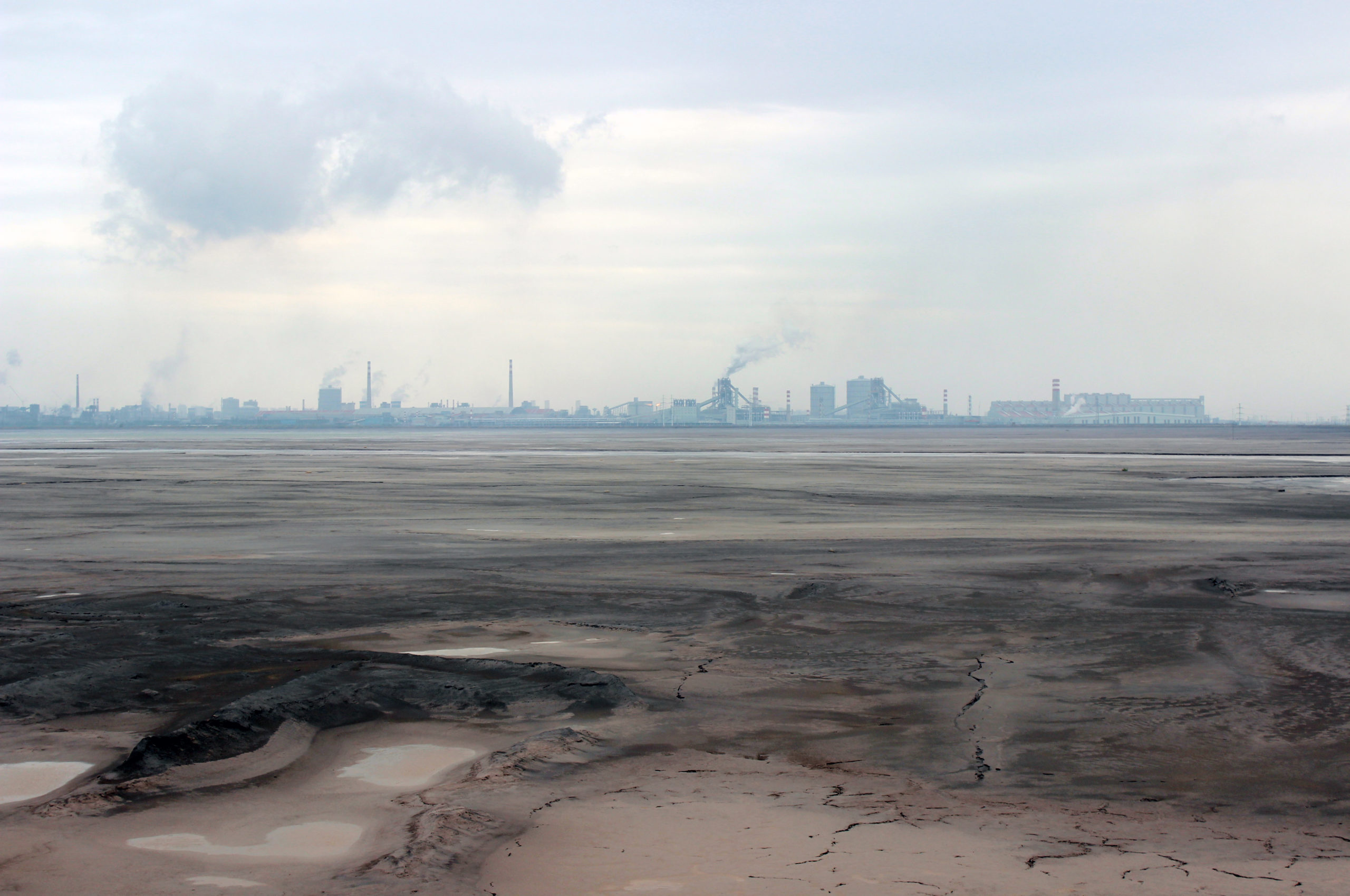
In Baotou, Inner Mongolia, the worlds largest rare earth mineral refinery pumps toxic and radioactive tailings into an adjacent artificial lake. Picture: Liam Young/Unknown Fields.
After photographing the desolate landscape of the tailings pond, they collected samples and boxed them up to send back to London, where they were analysed and weighed. Part of the Unknown Fields project is to produce work from each trip, including everything from films to physical objects. Young and Davies are now making traditional Ming vases out of the toxic clay, carefully measuring it so that each vase contains the amount of waste a single product necessitates. There will, for example, be an iPhone vase, a laptop vase, and an electric car vase. The vessels will be shown at the Victoria & Albert Museum in March.
“One of the largest contemporary loads on the rare earth industry is batteries — used in electric cards but also, the biggest draw is actually wind turbines,” says Young. “The renewable energy wind farms in the US and Scandinavia all begin their lives in a toxic lake in Inner Mongolia, which is a story that really needs to be told.”
A Better Way
After weeks of sailing and touring and trekking, what do Young and Davies hope their trip will achieve? According to Young, the group isn’t interested in the way the conservation industry traditionally operates: “This idea that you go out to a place, you show the world the photos of penguins covered in oil or the polar bears on the melting iceberg or the mine cut out of the rainforest, and the assumption is that once we have an awareness of what’s going on, we change what we do.” Because of a very simple reason: It doesn’t work. “We still do everything we do, even though we know we’re continually screwing the world.”
So what’s the alternative? Young and Davies imagine developing new technologies that are actually designed to fit the supply chain, rather than consumer demands.”So you could engineer an object at a small scale as a form of landscape in design, in a way,” Young says. “Setting in motion a supply chain that’s actually productive, not destructive.” In the short term, of course, there are basic things we can all do; starting with being aware, of course, but also knowing how and where to recycle our e-waste. For example, here’s the EPA’s advice on throwing away electronics, while most manufacturers run programs, too, listed here.
After having talked to Young about the trip, I was shocked by the complete lack of self-righteousness as he described what they had seen. That’s maybe the most telling thing about the project — the awareness that “we’re all complicit in this world that we’ve create for ourselves,” as Young says. “We’re trying to talk about these very nuanced and complex relationships that we’re all entwined within.”
Their goal isn’t to shame people into not participating in modern life, but to understand the systems that enable our lifestyles and belongings — the provenance of which we rarely consider — and, maybe, find a better way.
Picture: Shutterstock/zhangyang13576997233.
